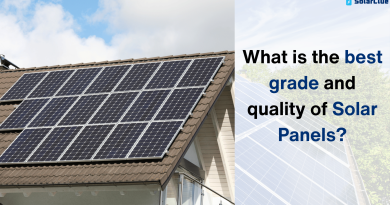How Is Electricity Stored From Solar Panels?
Energy storage is a critical component of solar power systems, enabling the storage of excess energy generated during the day for use when sunlight is not available. Batteries play a pivotal role in this process, ensuring a stable and reliable power supply. This guide explores the various aspects of energy storage in solar power systems, including the types of batteries used, their capacities, lifespans, and the challenges associated with battery storage.
Table of Contents
- 1 The Importance of Energy Storage in Solar Power Systems
- 2 Different Types of Batteries for Solar Storage
- 3 Battery Capacity and Its Impact on System Performance
- 4 Charging and Discharging Rates of Solar Batteries
- 5 Battery Lifespan and Maintenance
- 6 Challenges and Limitations of Battery Storage
- 7 The Future of Battery Technology for Solar Applications
- 8 Government Incentives and Rebates for Battery Storage
- 9 Case Studies of Successful Solar Energy Storage Systems
- 10 The Role of Battery Storage in Grid Stability
- 11 Table: Comparison of Different Types of Solar Batteries
- 12 FAQ Section
- 13 Conclusion
The Importance of Energy Storage in Solar Power Systems
1. Balancing Energy Supply and Demand
- Day-Night Cycle: Solar panels generate electricity only when the sun is shining, but energy demand often continues after sunset. Batteries store excess energy produced during the day for use at night or during cloudy periods.
- Energy Independence: Battery storage allows for greater energy independence, reducing reliance on the grid and ensuring a continuous power supply even during outages.
2. Maximizing Solar Energy Utilization
- Grid-Tied Systems: In grid-tied systems, stored energy can be used during peak demand times, reducing electricity costs and maximizing the use of solar power.
- Off-Grid Systems: For off-grid solar systems, batteries are essential to maintaining power availability around the clock, ensuring that the energy generated is not wasted.
Different Types of Batteries for Solar Storage
1. Lead-Acid Batteries
- Overview: Lead-acid batteries are the oldest and most commonly used type of battery for solar storage, known for their reliability and relatively low cost.
- Types:
- Flooded Lead-Acid (FLA): Requires regular maintenance, including checking water levels and equalizing charges.
- Sealed Lead-Acid (SLA): Maintenance-free, with a shorter lifespan than FLA batteries.
- Advantages: Cost-effective, widely available, and reliable.
- Disadvantages: Lower energy density, shorter lifespan, and regular maintenance required.
2. Lithium-Ion Batteries
- Overview: Lithium-ion batteries have become the preferred choice for solar energy storage due to their high energy density, longer lifespan, and low maintenance.
- Types:
- Lithium Iron Phosphate (LiFePO4): Known for safety and thermal stability.
- Nickel Manganese Cobalt (NMC): Offers a balance between energy density and lifespan.
- Advantages: High efficiency, longer lifespan, compact size, and low maintenance.
- Disadvantages: Higher upfront cost compared to lead-acid batteries.
3. Flow Batteries
- Overview: Flow batteries store energy in liquid electrolytes contained in external tanks, offering scalability and long-duration energy storage.
- Types:
- Vanadium Redox Flow Batteries: The most common type, known for long lifespan and scalability.
- Zinc-Bromine Flow Batteries: Offer high energy capacity and long life cycles.
- Advantages: Long lifespan, high scalability, and deep discharge capability.
- Disadvantages: Higher cost, complexity, and larger physical size.
Battery Capacity and Its Impact on System Performance
1. Understanding Battery Capacity
- Definition: Battery capacity, measured in kilowatt-hours (kWh), indicates the amount of energy a battery can store and deliver. It determines how long the battery can power your home or business when the solar panels are not generating electricity.
- Impact: Higher capacity batteries can store more energy, providing longer backup times and reducing reliance on the grid.
2. Sizing Your Battery
- Energy Needs: To determine the appropriate battery capacity, assess your daily energy consumption and the duration you need the battery to provide power.
- Solar System Size: The size of your solar power system also influences battery capacity requirements. Larger systems may require larger or multiple batteries to store excess energy effectively.
Charging and Discharging Rates of Solar Batteries
1. Charging Rate (C-Rate)
- Definition: The C-rate of a battery describes the speed at which it can be charged. A C-rate of 1C means the battery can be fully charged in one hour. A C-rate of 0.5C means it will take two hours.
- Impact: Faster charging rates allow for quicker replenishment of the battery during peak sunlight hours, but may reduce the battery’s lifespan if not managed properly.
2. Discharging Rate
- Definition: The discharging rate indicates how quickly a battery can release its stored energy. A higher discharging rate provides more power for high-demand situations but may deplete the battery faster.
- Balancing Act: Managing the charging and discharging rates is crucial to maintaining battery health and ensuring consistent performance.
Battery Lifespan and Maintenance
1. Factors Affecting Lifespan
- Depth of Discharge (DoD): Frequent deep discharges can shorten a battery’s lifespan. Maintaining a higher state of charge (SoC) extends the battery’s life.
- Temperature: Extreme temperatures, particularly heat, can degrade battery performance and reduce lifespan.
- Cycle Life: The number of charge-discharge cycles a battery can undergo before its capacity significantly declines.
2. Maintenance Tips
- Regular Monitoring: Monitor battery performance, including voltage and temperature, to detect potential issues early.
- Proper Ventilation: Ensure that batteries are stored in a well-ventilated area to prevent overheating.
- Avoid Deep Discharges: Aim to keep the battery’s state of charge above 50% to extend its lifespan.
Challenges and Limitations of Battery Storage
1. High Initial Cost
- Barrier to Adoption: The upfront cost of solar batteries, especially lithium-ion and flow batteries, can be a significant barrier for homeowners and businesses.
- Long Payback Period: The high cost may result in longer payback periods, depending on electricity savings and local incentives.
2. Limited Lifespan
- Degradation Over Time: Batteries degrade over time, losing capacity and efficiency, which can lead to replacement costs.
- Environmental Concerns: Disposal and recycling of used batteries pose environmental challenges, particularly for lead-acid batteries.
3. Energy Density
- Space Requirements: Batteries with lower energy density, such as lead-acid and flow batteries, require more space, which may be a limitation for residential installations.
The Future of Battery Technology for Solar Applications
1. Next-Generation Batteries
- Solid-State Batteries: Promising higher energy density, improved safety, and longer lifespan, solid-state batteries could revolutionize solar energy storage.
- Sodium-Ion Batteries: An emerging alternative to lithium-ion, sodium-ion batteries offer lower cost and abundant raw materials.
2. Advancements in Efficiency
- Improved Cycle Life: Ongoing research aims to extend the cycle life of batteries, reducing the need for frequent replacements.
- Faster Charging: Innovations in charging technology could lead to batteries that charge more quickly without compromising lifespan.
Government Incentives and Rebates for Battery Storage
1. Federal and State Incentives
- Investment Tax Credits (ITC): In many countries, including the U.S., the federal government offers tax credits for solar installations, including battery storage.
- State-Specific Programs: Several states offer additional rebates and incentives for battery storage systems, reducing the upfront cost.
2. Financing Options
- Solar Loans and Leases: Many financial institutions offer loans and leases that include battery storage as part of the solar installation package, making it more affordable.
- Utility Programs: Some utilities offer incentives for battery storage systems, particularly if they are integrated into demand response programs.
Case Studies of Successful Solar Energy Storage Systems
1. Residential Solar Plus Storage
- Location: A homeowner in California installed a 10 kWh lithium-ion battery alongside a 5 kW solar panel system.
- Outcome: The system provided reliable backup power during frequent grid outages, reducing reliance on the grid and saving on electricity bills.
2. Commercial Solar Storage
- Location: A commercial facility in Australia implemented a large-scale solar-plus-storage system using flow batteries.
- Outcome: The system enabled the facility to manage peak demand, lower energy costs, and participate in the local demand response program.
3. Off-Grid Solar System
- Location: A remote cabin in Alaska installed an off-grid solar system with a lead-acid battery bank.
- Outcome: The system provided year-round power, with the battery bank offering sufficient storage to cover long periods of low sunlight in winter.
The Role of Battery Storage in Grid Stability
1. Grid Balancing
- Demand Response: Batteries can be used in demand response programs to help balance the grid by storing excess energy during low demand and releasing it during peak demand.
- Frequency Regulation: Batteries provide fast response times, making them ideal for maintaining grid frequency stability.
2. Enhancing Renewable Integration
- Smoothing Intermittency: Battery storage smooths the intermittency of renewable energy sources like solar, enabling higher penetration of renewables in the energy mix.
- Microgrids and Energy Resilience: Batteries are essential in microgrids, providing energy resilience and reducing dependency on centralized power plants.
Table: Comparison of Different Types of Solar Batteries
| Battery Type | Energy Density | Lifespan (Cycles) | Maintenance | Cost | Ideal Use |
|---|---|---|---|---|---|
| Lead-Acid (Flooded) | Low | 500-1000 | High (regular) | Low | Off-grid, backup power |
| Lead-Acid (Sealed) | Low | 400-800 | Low (maintenance-free) | Low | Small-scale solar, backup power |
| Lithium-Ion | High | 3000-5000 | Low (maintenance-free) | High | Residential, commercial, off-grid |
| Flow Batteries | Medium | 5000+ | Low | High | Utility-scale, large commercial |
| Solid-State (Emerging) | Very High | 5000+ (estimated) | Low | Very High (future) | Future applications |
| Sodium-Ion (Emerging) | Medium | 2000+ (estimated) | Low | Moderate (future) | Future applications |
FAQ Section
What type of battery is best for solar energy storage?
Lithium-ion batteries are currently the best choice for most solar energy storage applications due to their high efficiency, long lifespan, and low maintenance. Lead-acid batteries are more cost-effective but have a shorter lifespan.
How long do solar batteries last?
The lifespan of a solar battery depends on its type and usage. Lead-acid batteries typically last 3-5 years, while lithium-ion batteries can last 10-15 years with proper maintenance.
Can I add a battery to my existing solar panel system?
Yes, batteries can be added to an existing solar panel system, though it may require some modifications. It’s advisable to consult with a solar professional to ensure compatibility and optimal performance.
What are the main challenges of using batteries for solar energy storage?
The main challenges include the high upfront cost, limited lifespan, and energy density. Additionally, battery disposal and recycling pose environmental challenges.
Are there government incentives for installing solar batteries?
Yes, many governments offer incentives such as tax credits, rebates, and grants to encourage the installation of solar batteries, reducing the overall cost of the system.
Conclusion
Energy storage is a vital component of solar power systems, enabling the effective use of solar energy even when the sun isn’t shining. By understanding the different types of batteries, their capacities, and the challenges associated with battery storage, homeowners and businesses can make informed decisions about their solar energy systems. As battery technology continues to evolve, the future holds promise for more efficient, cost-effective, and environmentally friendly energy storage solutions, further enhancing the viability of solar power as a primary energy source.



